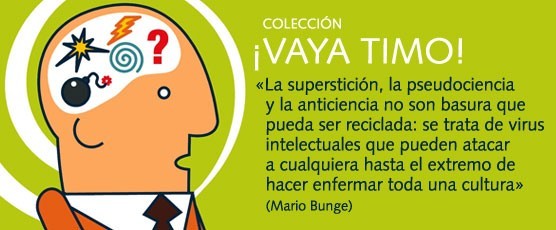'Is this worth purchasing?' is a question I have asked myself many times over the years, when a new book title on vampires and related subjects turned up. Fortunately, with the internet one can sometimes find a reasonable amount of reviews and other information, but in many cases you are left to make a decision on the basis of almost no information at all. For that reason, over the years I have tried to write a bit about various books that might have some value for people with an interest in the subject of vampirism and posthumous magic along the lines of this blog.
Jordi Ardanuy is a physicist and vampire expert who has written extensively in Catalan and Spanish. Much of what he has written on the subject is available on the internet, cf. e.g. the web site of Cercle V, but I have been intrigued to see his book Los vampiros ¡vaya timo! published by Laetoli in 2009 in a series on superstition, pseudoscience and antisicence called ¡Vaya timo! aimed at teenagers and other younger readers. Other books in the series deal with e.g. witchcraft, tarot and psychoanalysis.
Ardanuy's book is short, containing only about 130 pages, and is no doubt easily read if you know Spanish. The first chapter deals with Lilith, lamiae, ghosts, incubi and efialtes, and the second contains annotated translations from Henry More and Valvasor on the shoemaker from Silesia, Johannes Cuntius, and Giure Grando. Chapters 3, 4 and 5 deal with the famous Serbian vampire cases, the 18th century debate on vampires, Van Swieten's commentaries, also drawing lines ahead to e.g. the vampire beliefs and traits in 19th century New England. Finally, chapters 6 and 7 are concerned with the fictional vampire and the modern conception of vampires.
So, overall it looks like it contains standard information the subject that can be found elsewhere. The main exception is probably a few pages dealing with the critical reaction of the Spanish benedictine monk Benito Jéronimo Feijoo to Dom Calmet's work on revenants and vampires. Although not frequently mentioned in books on vampires, Feijoo's critique of Calmet is touched upon in e.g. Fernando Vidal's paper Ghosts, the economy of religion, and the laws of princes. Dom Calmet's Treatise on the apparitions of spirits in Gespenster und Politik, edited by Claire Gantet and Fabrice d'Almeida (Wilhelm Fink, 2007).
Ardanuy's list of recommended further reading is brief, mentioning works by Paul Barber, Jan Bondeson (a Spanish translation of his book on premature burial, Buried Alive), Robert Eighteen-Bisang and Elizabeth Miller, and Jean Marigny, including only one Spanish book: Vampiros y hombres lobo by Erberto Petoia.



No comments:
Post a Comment